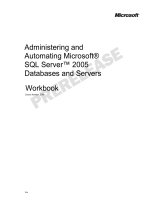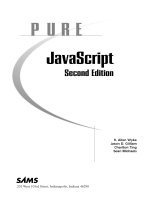SQL Server Execution Plans Second Edition pot
Bạn đang xem bản rút gọn của tài liệu. Xem và tải ngay bản đầy đủ của tài liệu tại đây (15.75 MB, 333 trang )
SQL Handbooks
SQL Server
Execution Plans
Second Edition
By Grant Fritchey
SQL Server Execution Plans
Second Edition
By Grant Fritchey
Published by Simple Talk Publishing September 2012
First Edition 2008
Copyright Grant Fritchey 2012
ISBN: 978-1-906434-92-2
The right of Grant Fritchey to be identified as the author of this work has been asserted by him in accordance
with the Copyright, Designs and Patents Act 1988
All rights reserved. No part of this publication may be reproduced, stored or introduced into a retrieval
system, or transmitted, in any form, or by any means (electronic, mechanical, photocopying, recording or
otherwise) without the prior written consent of the publisher. Any person who does any unauthorized act in
relation to this publication may be liable to criminal prosecution and civil claims for damages.
This book is sold subject to the condition that it shall not, by way of trade or otherwise, be lent, re-sold,
hired out, or otherwise circulated without the publisher's prior consent in any form other than which it is
published and without a similar condition including this condition being imposed on the subsequent
publisher.
Technical Reviewer: Brad McGehee
Editors: Tony Davis and Brad McGehee
Cover Image by Andy Martin
Typeset by Peter Woodhouse & Gower Associates
Table of Contents
Introduction ___________________________________________ 13
Changes in This Second Edition _________________________________________ 15
Code Examples _______________________________________________________16
Chapter 1: Execution Plan Basics _________________________18
What Happens When a Query is Submitted? _______________________________ 19
Query parsing _____________________________________________________ 19
Algebrizer ________________________________________________________ 20
The query optimizer ________________________________________________ 21
Query execution ___________________________________________________24
Estimated and Actual Execution Plans ____________________________________25
Execution Plan Reuse _________________________________________________ 26
Clearing Plans from the Plan Cache ______________________________________28
Execution Plan Formats _______________________________________________ 29
Graphical plans ____________________________________________________29
Text plans _________________________________________________________29
XML plans ________________________________________________________30
Getting Started _______________________________________________________ 31
Permissions required to view execution plans ____________________________ 31
Working with graphical execution plans ________________________________ 32
Working with text execution plans _____________________________________42
Working with XML execution plans ___________________________________ 46
Interpreting XML plans ______________________________________________47
Retrieving Plans from the Cache Using Dynamic Management Objects ________ 51
Automating Plan Capture Using SQL Server Trace Events ___________________ 53
Execution plan events _______________________________________________54
Capturing a Showplan XML trace ______________________________________56
Why the actual and estimated execution plans might differ _________________59
Summary ____________________________________________________________61
Chapter 2: Graphical Execution Plans for Basic Queries _____ 62
The Language of Graphical Execution Plans ______________________________ 62
Some Single Table Queries ______________________________________________ 65
Clustered Index Scan ________________________________________________ 65
Clustered Index Seek _______________________________________________ 68
NonClustered Index Seek ___________________________________________ 70
Key Lookup _______________________________________________________ 73
Table Scan ________________________________________________________79
RID Lookup ______________________________________________________ 80
Table Joins ___________________________________________________________83
Hash Match join __________________________________________________ 86
Nested Loops join _________________________________________________ 89
Compute Scalar ____________________________________________________92
Merge Join ________________________________________________________93
Filtering Data _______________________________________________________ 96
Execution Plans with GROUP BY and ORDER BY _________________________ 99
Sort _____________________________________________________________ 99
Hash Match (aggregate) _____________________________________________ 103
Filter ____________________________________________________________104
A brief aside on rebinds and rewinds __________________________________ 105
Execution Plans for INSERT, UPDATE and DELETE Statements _____________108
INSERT statements ________________________________________________109
UPDATE statements _______________________________________________ 112
DELETE statements _______________________________________________ 114
Summary ___________________________________________________________ 114
Chapter 3: Text and XML Execution Plans for Basic Queries __ 116
Text Execution Plans _________________________________________________ 117
A text plan for a simple query ________________________________________ 117
A text plan for a slightly more complex query ___________________________ 121
XML Execution Plans _________________________________________________126
An estimated XML plan _____________________________________________ 127
An actual XML plan ________________________________________________ 134
Querying the XML _________________________________________________ 135
Summary ________________________________________________________ 137
Chapter 4: Understanding More Complex Query Plans ______138
Stored procedures _________________________________________________ 138
Using a sub-select _________________________________________________ 141
Derived tables using APPLY _________________________________________ 145
Common table expressions __________________________________________149
MERGE _________________________________________________________ 154
Views ___________________________________________________________ 159
Indexes __________________________________________________________ 164
Summary ________________________________________________________ 176
Chapter 5: Controlling Execution Plans with Hints _________ 177
Query Hints _________________________________________________________178
HASH|ORDER GROUP ____________________________________________ 178
MERGE |HASH |CONCAT UNION ___________________________________ 182
LOOP|MERGE|HASH JOIN _________________________________________ 185
FAST n __________________________________________________________190
FORCE ORDER ___________________________________________________ 191
MAXDOP ________________________________________________________ 196
OPTIMIZE FOR __________________________________________________199
PARAMETERIZATION SIMPLE|FORCED _____________________________205
RECOMPILE _____________________________________________________205
ROBUST PLAN __________________________________________________ 208
KEEP PLAN _____________________________________________________ 209
KEEPFIXED PLAN _________________________________________________ 210
EXPAND VIEWS __________________________________________________ 210
MAXRECURSION _________________________________________________ 212
USE PLAN _______________________________________________________ 212
Join Hints ___________________________________________________________ 212
LOOP ___________________________________________________________ 213
MERGE _________________________________________________________ 216
Table Hints _________________________________________________________ 218
Table hint syntax __________________________________________________ 218
NOEXPAND _____________________________________________________ 219
INDEX() _________________________________________________________ 221
FASTFIRSTROW _________________________________________________ 223
Summary ___________________________________________________________226
Chapter 6: Cursor Operations ___________________________227
Simple cursors _______________________________________________________227
Logical operators __________________________________________________229
Physical operators _________________________________________________ 237
More cursor operations _______________________________________________238
Static cursor ______________________________________________________ 238
Keyset cursor _____________________________________________________ 243
READ_ONLY cursor _______________________________________________246
Cursors and performance _____________________________________________247
Summary ___________________________________________________________254
Chapter 7: Special Datatypes and Execution Plans _________255
XML _______________________________________________________________ 255
FOR XML ________________________________________________________ 257
OPENXML _______________________________________________________266
XQuery __________________________________________________________ 271
Hierarchical Data ____________________________________________________279
Spatial Data _________________________________________________________282
Summary __________________________________________________________ 286
Chapter 8: Advanced Topics ___________________________ 287
Reading Large-scale Execution Plans ___________________________________ 288
Parallelism in Execution Plans _________________________________________295
Max degree of parallelism ___________________________________________296
Cost threshold for parallelism ________________________________________297
Are parallel plans good or bad? _______________________________________298
Examining a parallel execution plan __________________________________ 299
How Forced Parameterization Affects Execution Plans _____________________305
Using Plan Guides to Modify Execution Plans _____________________________ 310
Object plan guides ________________________________________________ 311
SQL plan guides ___________________________________________________ 314
Template plan guides _______________________________________________ 315
Plan guide administration ___________________________________________ 316
Plan forcing ______________________________________________________ 317
Summary ___________________________________________________________ 321
ix
About the Author
Grant Fritchey is a SQL Server MVP with over 20 years' experience in IT including time
spent in support, development, and database administration.
Grant has worked with SQL Server since version 6.0, back in 1995. He has developed in
VB, VB.Net, C#, and Java. Grant joined Red Gate as a Product Evangelist in January 2011.
He writes articles for publication at SQL Server Central, Simple-Talk, and other
community sites, and has published two books: the one you're reading now and SQL
Server 2012 Query Performance Tuning Distilled, 3rd Edition (Apress, 2012).
In the past, people have called him intimidating and scary. To which his usual reply is
"Good."
You can contact him through grant -at- scarydba dot kom (de-obfuscate as necessary).
About the Technical Reviewer
Brad M. McGehee is a MCTS, MCSE+I, MCSD, and MCT (former) with a Bachelor's
degree in Economics and a Master's in Business Administration. Currently a DBA with a
Top 10 accounting firm, Brad is an accomplished Microsoft SQL Server MVP with over 17
years' SQL Server experience, and over 8 years' training experience; he has been involved
in IT since 1982.
Brad is a frequent speaker at SQL PASS, European PASS, SQL Server Connections,
SQLTeach, devLINK, SQLBits, SQL Saturdays, TechFests, Code Camps, SQL in the City,
SQL Server user groups, webinars, and other industry seminars, where he shares his 17
years of cumulative knowledge and experience.
x
In 2009, 2010, and 2011, Brad has made 86 different public presentations to a total of
6,750 attendees in six different countries.
Brad was the founder of the popular community site, .SQL--.
, and operated it from 2000 through 2006, where he wrote over one million words on
SQL Server topics.
A well-respected and trusted name in SQL Server literature, Brad is the author or
co-author of more than 15 technical books and over 300 published articles. His most
recent books include How to Become an Exceptional DBA (2nd Edition), Brad's Sure Guide
to SQL Server 2008: The Top Ten New Features for DBAs, Mastering SQL Server Profiler,
and Brad's Sure Guide to SQL Server Maintenance Plans. These books are available,
free, in PDF format at: :..B. His blog is
at ...
11
Foreword
I have attended many SQL Server conferences since 2000, and I have spoken with
hundreds of people attending them. One of the most significant trends I have noticed
over the past 12 years is the huge number of people who have made the transition from
IT Professional or Developer, to SQL Server Database Administrator. In some cases, the
transition has been planned and well thought-out. In other cases, it was an accidental
transition, when an organization desperately needed a DBA, and the closest warm body
was chosen for the job.
No matter the route you took to get there, all DBAs have one thing in common: we have
had to learn how to become DBAs through self-training, hard work, and trial and error. In
other words, there is no school you can attend to become a DBA; it is something you have
to learn on your own. Some of us are fortunate to attend a class or two, or to have a great
mentor to help us. However, in most cases, we DBAs become DBAs the hard way: we are
thrown into the water and we either sink or swim.
One of the biggest components of a DBA's self-learning process is reading. Fortunately,
there are many good books on the basics of being a DBA that make a good starting point
for your learning journey. Once you have read the basic books and have gotten some
experience under your belt, you will soon want to know more of the details of how SQL
Server works. While there are a few good books on the advanced use of SQL Server, there
are still many areas that aren't well covered. One of those areas of missing knowledge is a
dedicated book on SQL Server execution plans.
That's where SQL Server Execution Plans comes into play. It is the first book available
anywhere that focuses entirely on what SQL Server execution plans are, how to read
them, and how to apply the information you learn from them in order to boost the
performance of your SQL Servers.
12
This was not an easy book to write because SQL Server execution plans are not well
documented. Grant Fritchey spent a huge amount of time researching SQL Server
execution plans, and conducting original research as necessary, in order to write the
material in this book. Once you understand the fundamentals of SQL Server, this book
should be on top of your reading list, because understanding SQL Server execution plans
is a critical part of becoming an Exceptional DBA.
As you read the book, take what you have learned and apply it to your own unique set of
circumstances. Only by applying what you have read will you be able to fully understand
and grasp the power of what execution plans have to offer.
Brad M McGehee
Springfield, MO USA 2012
13
Introduction
Every day, out in the various discussion boards devoted to Microsoft SQL Server, the
same types of questions come up repeatedly:
• Why is this query running slow?
• Is SQL Server using my index?
• Why isn't SQL Server using my index?
• Why does this query run faster than this query?
• And so on (and on).
The correct response is probably different in each case, but in order to arrive at the
answer you have to ask the same return question every time: have you looked at the
execution plan?
Execution plans show you what's going on behind the scenes in SQL Server. They can
provide you with a wealth of information on how SQL Server is executing your queries,
including the points below.
• Which indexes are getting used, and where no indexes are being used at all.
• How the data is being retrieved, and joined, from the tables defined in your query.
• How aggregations in GROUP BY queries are put together.
• The anticipated load, and the estimated cost, that all these operations place upon
the system.
All this information makes the execution plan a fairly important tool in the tool belt of
database administrator, database developers, report writers, developers, and pretty much
anyone who writes T-SQL to access data in a SQL Server database.
14
Given the utility and importance of the tool, you'd think there'd be huge swathes of infor-
mation devoted to this subject. To be sure, fantastic information is available from various
sources, but there isn't one place to go for focused, practical information on how to use
and interpret execution plans.
This is where my book comes in. My goal was to gather into a single location as much
useful information on execution plans as possible. I've tried to organize this information
in such a way that it provides a clear route through the subject, right from the basics
of capturing plans, through their interpretation, and then on to how to use them to
understand how you might optimize your SQL queries, improve your indexing strategy,
and so on.
Specifically, I cover:
• How to capture execution plans in graphical, as well as text and XML formats.
• A documented method for interpreting execution plans, so that you can create these
plans from your own code and make sense of them in your own environment.
• How SQL Server represents and interprets the common SQL Server objects – indexes,
views, derived tables and so on, in execution plans.
• How to spot some common performance issues such as Bookmark Lookups or
unused/missing indexes.
• How to control execution plans with hints, plan guides and so on, and why this is a
double-edged sword.
• How XML code appears in execution plans.
• Advanced topics such as parallelism, forced parameterization and plan forcing.
Along the way, I tackle such topics as SQL Server internals, performance tuning, index
optimization and so on. However, I focus always on the details of the execution plans,
and how these issues are manifest in these plans.
15
If you are specifically looking for information on how to optimize SQL, or build ecient
indexes, then you need a book dedicated to these topics. However, if you want to under-
stand how to interpret these issues within an execution plan, then this is the place
for you.
Changes in This Second Edition
This second edition is more evolution than revolution. I spent a lot of time clarifying the
descriptions of all of the major plan operators, updating the examples that illustrated how
these operators manifest in SQL Server's execution plans, and improving the descriptions
of how to read and interpret these plans, in all their guises (graphical, text, and XML).
There is also plenty of new content in here, including coverage of topics such as:
• How to get the cached execution plan for a query, using the Dynamic Management
Views (DMVs).
• Expanded coverage of reading XML plans, including how to use XQuery to query
cached plans.
• Discussion of the MERGE statement and how it manifests in execution plans.
• Expanded coverage of complex data types, to include hierarchical and spatial data as
well as XML.
• How to read large-scale plans using XQuery.
• Additional functionality added to SQL Server 2012.
From this point forward, I plan to embark on a program of "continuous improvement,"
gradually adding new content, and updating existing content for a more complete set of
information on SQL Server 2012.
16
I'll push out updated versions of the eBook, at semi-regular intervals, for you to download
and provide your feedback.
Be sure to check out the website for this book:
(:.-.----),
where you can:
• Find links to download the latest versions of the eBook and buy the latest
printed book.
• Sign up to receive email notifications when I release a new eBook version.
• View the "Change Log," describing what has changed in each new version.
• Most importantly, let me know what you think! Seriously, hit me with whatever
feedback you have. Be honest, brutal…scary even, if necessary. If you provide feedback
that makes it into the next edition of the book, you'll receive an Amazon voucher to
buy yourself a copy of the latest printed version.
Enjoy the book, and I look forward to hearing from you!
Code Examples
Throughout this book, I'll be supplying T-SQL code that you're encouraged to run for
yourself, in order to generate the plans we'll be discussing. From the following URL,
you can obtain all the code you need to try out the examples in this book:
.-.RGBGF_SQLSEP_
C.
I wrote and tested the examples on SQL 2008 Release 2 sample database, Adventure-
Works2008R2. However, the majority of the code will run on all editions and versions of
SQL Server, starting from SQL Server 2005.
17
Some of the code may not work within SQL Azure, but a large amount of it will. You can
get hold of get a copy of AdventureWorks from CodePlex:
:..MSFTDBPS.
If you are working with procedures and scripts other than those supplied, please
remember that encrypted stored procedures will not display an execution plan.
The initial execution plans will be simple and easy to read from the samples presented in
the text. As the queries and plans become more complicated, the book will describe the
situation but, in order to see the graphical execution plans or the complete set of XML,
it will be necessary for you to generate the plans. So, please, read this book next to your
machine, if possible, so that you can try running each query yoursel!
18
Chapter 1: Execution Plan Basics
An execution plan, simply put, is the result of the query optimizer's attempt to
calculate the most ecient way to implement the request represented by the T-SQL
query you submitted.
Execution plans can tell you how SQL Server may execute a query, or how it did execute
a query. They are, therefore, the primary means of troubleshooting a poorly performing
query. Rather than guess at why a given query is performing thousands of scans, putting
your I/O through the roof, you can use the execution plan to identify the exact piece of
SQL code that is causing the problem. For example, your query may be reading an entire
table-worth of data when, by removing a function in your WHERE clause, it could simply
retrieve only the rows you need. The execution plan displays all this and more.
The aim of this chapter is to teach you to capture actual and estimated execution plans,
in either graphical, text or XML format, and to understand the basics of how to interpret
these plans. In order to do this, we'll cover the following topics:
• A brief backgrounder on the query optimizer – Execution plans are a result of
the optimizer's operations so it's useful to know at least a little bit about what the
optimizer does, and how it works.
• Actual and estimated execution plans – What they are and how they differ.
• Capturing and interpreting the different visual execution plan formats – We'll
investigate graphical, text and XML execution plans.
• Retrieve execution plans directly from the cache – Accessing the plan cache
through Dynamic Management Objects (DMOs).
• Automating execution plan capture – using SQL Server Trace Event.
19
Chapter 1: Execution Plan Basics
What Happens When a Query is Submitted?
When you submit a query to SQL Server, a number of processes on the server go to work
on that query. The purpose of all these processes is to manage the system such that it will
SELECT, INSERT, UPDATE or DELETE the data.
These processes kick into action every time we submit a query to the system. While there
are many different actions occurring simultaneously within SQL Server, we're going to
focus on the processes around queries. The processes for meeting the requirements of
queries break down roughly into two stages:
1. Processes that occur in the relational engine.
2. Processes that occur in the storage engine.
In the relational engine, the query is parsed and then processed by the query optimizer,
which generates an execution plan. The plan is sent (in a binary format) to the storage
engine, which then uses that plan as a basis to retrieve or modify the underlying data. The
storage engine is where processes such as locking, index maintenance, and transactions
occur. Since execution plans are created in the relational engine, that's where we'll be
focusing the majority of our attention.
Query parsing
When we pass a T-SQL query to the SQL Server system, the first place it goes to is the
relational engine.
1
As the T-SQL arrives, it passes through a process that checks that the
T-SQL is written correctly, that it's well formed. This process is query parsing. If a query
fails to parse correctly, for example, if you type SELETC instead of SELECT, then parsing
1 A T-SQL query can be an ad hoc query from a command line or a call to request data from a stored procedure, any T-SQL within a
single batch or a stored procedure, or between GO statements.
20
Chapter 1: Execution Plan Basics
stops and SQL Server returns an error to the query source. The output of the Parser
process is a parse tree, or query tree (or it's even called a sequence tree). The parse tree
represents the logical steps necessary to execute the requested query.
If the T-SQL string is not a data manipulation language (DML) statement, but instead is
a data definition language (DDL) query, it will be not be optimized because, for example,
there is only one "right way" for the SQL Server system to create a table; therefore, there
are no opportunities for improving the performance of that type of statement.
Algebrizer
If the T-SQL string is a DML statement and it has parsed correctly, the parse tree is passed
to a process called the algebrizer. The algebrizer resolves all the names of the various
objects, tables and columns, referred to within the query string. The algebrizer identifies,
at the individual column level, all the data types (varchar(50) versus datetime and so
on) for the objects being accessed. It also determines the location of aggregates (such as
GROUP BY, and MAX) within the query, a process called aggregate binding. This algebrizer
process is important because the query may have aliases or synonyms, names that don't
exist in the database, that need to be resolved, or the query may refer to objects not in
the database. When objects don't exist in the database, SQL Server returns an error from
this step, defining the invalid object name. As an example, the algebrizer would quickly
find the table Person.Person in the AdventureWorks2008R2 database. However,
the Product.Person table, which doesn't exist, would cause an error and the whole
optimization process would stop.
The algebrizer outputs a binary called the query processor tree, which is then passed
on to the query optimizer. The algebrizer's output includes a hash, a coded value repre-
senting the query. The optimizer uses the hash to determine whether there is already a
plan generated and stored in the plan cache. If there is a plan there, the process stops here
and that plan is used. This reduces all the overhead required by the query optimizer to
generate a new plan.
21
Chapter 1: Execution Plan Basics
The query optimizer
The query optimizer is essentially a piece of software that "models" the way in which
the database relational engine works. The most important pieces of data used by the
optimizer are statistics, which SQL Server generates and maintains against indexes and
columns, explicitly for use by the optimizer. Using the query processor tree and the
statistics it has about the data, the optimizer applies the model in order to work out
what it thinks will be the optimal way to execute the query – that is, it generates an
execution plan.
In other words, the optimizer figures out how best to implement the request represented
by the T-SQL query you submitted. It decides if it can access the data through indexes,
what types of joins to use and much more. The decisions made by the optimizer are based
on what it calculates to be the cost of a given execution plan, in terms of the required
CPU processing and I/O. Hence, this is a cost-based plan.
The optimizer will generate and evaluate many plans (unless there is already a cached
plan) and, generally speaking, will choose the lowest-cost plan, that is, the plan it thinks
will execute the query as fast as possible and use the least amount of resources, CPU and
I/O. The calculation of the execution cost is the most important calculation, and the
optimizer will use a process that is more CPU-intensive if it returns results that much
faster. Sometimes, the optimizer will settle for a less ecient plan if it thinks it will take
more time to evaluate many plans than to run a less ecient plan. The optimizer doesn't
find the best possible plan. The optimizer finds the plan with the least cost in the shortest
possible number of iterations, meaning the least amount of time within the processor.
If you submit a very simple query – for example, a SELECT statement against a single
table with no aggregates or calculations within the query – then, rather than spend time
trying to calculate the absolute optimal plan, the optimizer will simply apply a trivial
plan to these types of queries. For example, a query like the one in Listing 1.1 would create
a trivial plan.
22
Chapter 1: Execution Plan Basics
SELECT d.Name
FROM HumanResources.Department AS d
WHERE d.DepartmentID = 42
Listing 1.1
Adding even one more table, with a JOIN, would make the plan non-trivial. If the query is
non-trivial, the optimizer will perform a cost-based calculation to select a plan. In order
to do this, it relies on the statistics that by SQL Server maintains.
Statistics are collected on columns and indexes within the database, and describe the data
distribution and the uniqueness, or selectivity, of the data. We don't want the optimizer
to read all the data in all the tables referenced in a query each time it tries to generate a
plan, so it relies on statistics, a sample of the data that provides a mathematical construct
of the data used by the optimizer to represent the entire collection of data. The reliance
the optimizer has on statistics means that these things need to be as accurate as possible
or the optimizer could make poor choices for the execution plans it creates.
The information that makes up statistics is represented by a histogram, a tabulation
of counts of the occurrence of a particular value, taken from 200 data points evenly
distributed across the data. It's this "data about the data" that provides the information
necessary for the optimizer to make its calculations.
If statistics exist for a relevant column or index, then the optimizer will use them in its
calculations. The optimizer will examine the statistics to determine if the index supplies
a sucient level of selectivity to act as assistance for the query in question. Selectivity is
how unique the data is across the whole set of the data. The level of selectivity required
to be of assistance for an index is quite high, usually with x% of unique values required in
most instances.
Statistics, by default, are created and updated automatically within the system for all
indexes or for any column used as a predicate, as part of a WHERE clause or JOIN ON
clause. Table variables do not ever have statistics generated on them, so the optimizer
always assumes they contain a single row, regardless of their actual size.
23
Chapter 1: Execution Plan Basics
Temporary tables do have statistics generated on them and their statistics are
stored in the same type of histogram as permanent tables, and the optimizer can
use these statistics.
The optimizer takes these statistics, along with the query processor tree, and heuristi-
cally determines the best plan. This means that it works through a series of plans, testing
different methods of accessing data, attempting different types of join, rearranging the
join order, trying different indexes, and so on, until it arrives at what it thinks will be the
least cost plan. During these calculations, the optimizer assigns a number to each of the
steps within the plan, representing its estimation of the combined amount of CPU and
disk I/O time it thinks each step will take. This number is the estimated cost for that step.
The accumulation of costs for each step is the estimated cost for the execution plan itself.
It's important to note that the estimated cost is just that – an estimate. Given an infinite
amount of time and complete, up-to-date statistics, the optimizer would find the perfect
plan for executing the query. However, it attempts to calculate the best plan it can in the
least amount of time possible, and is limited by the quality of the statistics it has available.
Therefore, these cost estimations are very useful as measures, but are unlikely to reflect
reality precisely.
Once the optimizer arrives at an execution plan, the estimated plan is created and stored
in a memory space known as the plan cache – although this is all different if a plan
already exists in cache (more on this shortly, in the section on Execution Plan Reuse).
As stated earlier, if the optimizer finds a plan in the cache that matches the currently
executing query, this whole process is short-circuited.
24
Chapter 1: Execution Plan Basics
Query execution
Once the optimizer has generated an execution plan, or retrieved one from cache, the
action switches to the storage engine, which usually executes the query according to
the plan.
We will not go into detail here, except to note that the carefully generated execution plan
may be subject to change during the actual execution process. For example, this might
happen if:
• SQL Server determines that the plan exceeds the threshold for a parallel execution
(an execution that takes advantage of multiple processors on the machine – more on
parallel execution in Chapter 3)
• the statistics used to generate the plan were out of date, or have changed since the
original execution plan was created
• processes or objects within the query, such as data inserts to a temporary table, result
in a recompilation of the execution plan.
Any one of these could change the estimated execution plan.
SQL Server returns the results of the query after the relational engine changes the format
to match that requested in the submitted T-SQL statement, assuming it was a SELECT.
25
Chapter 1: Execution Plan Basics
Estimated and Actual Execution Plans
As discussed previously, there are two distinct types of execution plan. First, there is the
plan that represents the output from the optimizer. This is an estimated execution plan.
The operators, or steps, within the plan are logical steps, because they're representative
of the optimizer's view of the plan and don't represent what physically occurs when the
query runs.
Next is the plan that represents the output from the actual query execution. This type
of plan is, funnily enough, the actual execution plan. It shows data representing what
actually happened when the query executed.
These plans represent distinctly different sets of data, but can look largely the same. Most
of the time, the same operators with the same costs will be present in both plans. There
are occasions where, usually due to recompiles, SQL Server will drop a plan from the plan
cache and recreate it, and these versions can differ greatly. The cause is usually changes
in statistics, or other changes that occur as the storage engine processes the queries. We'll
discuss this issue in more detail a little later in the chapter.
Estimated plans are the types of plans stored in the plan cache, so this means that we
can access the data available in actual execution plans only by capturing the execution of
a query. Since estimated plans never access data, they are very useful for large, complex
queries that could take a long time to run. Actual execution plans are preferred because
they show important execution statistics such as the number of rows accessed by a given
operator. In general, this additional information makes actual execution plans the one
you use the most, but estimated plans are extremely important, especially because that's
what you get from the plan cache.









